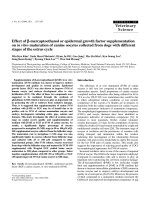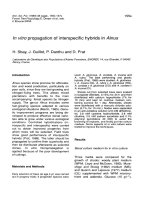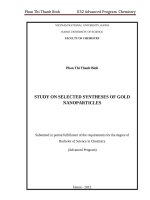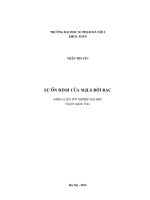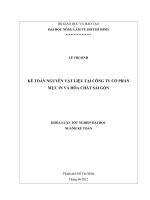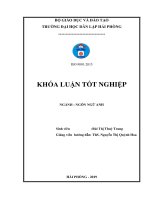Research on in vitro propagation of schismatoglottis wallichii (khóa luận tốt nghiệp)
Bạn đang xem bản rút gọn của tài liệu. Xem và tải ngay bản đầy đủ của tài liệu tại đây (1.59 MB, 71 trang )
VIETNAM NATIONAL UNIVERSITY OF AGRICULTURE
FACULTY OF BIOTECHNOLOGY
-------------***-------------
GRADUATION THESIS
TOPIC: RESEARCH ON IN VITRO PROPAGATION
OF SCHISMATOGLOTTIS WALLICHII
HANOI – 2022
VIETNAM NATION UNIVERSITY OF AGRICULTURE
FACULTY OF BIOTECHNOLOGY
– – – – – – – – – – – –
GRADUATION THESIS
TOPIC: “RESEARCH ON IN VITRO PROPAGATION
OF SCHISMATOGLOTTIS WALLICHII”
Supervisor
: Dr. Nguyen Thi Lam Hai
Student name
: Le Thi Phuong Oanh
Student code
: 637061
Class
: K63CNSHE
HA NOI – 2022
DECLARATION OF AUTHORSHIP
I hereby declare that this is my research work. The data, results and reports
mentioned herein are honest and have not been used to be published in previous
theses, dissertations, and scientific research works.
I hereby certify that the citation information used in the thesis is clearly
stated in the source, ensuring that the citation is correct as prescribed.
I take full responsibility for this promise!
Hanoi, day month year 2022
Student
Le Thi Phuong Oanh
i
ACKNOWLEDGEMENTS
In order to complete this graduation thesis, I would like to thank the Faculty
of Biotechnology of Vietnam National University of Agriculture for organizing
and facilitating support and assistance in the process of studying and researching
the topic.
With the deepest gratitude, I would like to send to the teachers in the
Department of Plant - Faculty of Biotechnology of Vietnam National University
of Agriculture, especially Dr. Nguyen Thi Lam Hai, who followed me closely
during the research and imparted valuable knowledge to us. throughout the time
at school. Thanks to the guidance and teaching of the teachers, my research topic
can be completed well.
I would like to sincerely thank Mr. Vu Cong Son and the staff at T.E.N
Biotech Biological Joint Stock Company - who directly helped, cared and guided
me to successfully complete this report in the past time.
The final thesis was carried out over a period of nearly 6 months. My initial
step into practice is still limited and there are still many surprises, so it is inevitable
that I will make mistakes, I look forward to receiving valuable comments from
teachers so that my knowledge in this field can be improved. more complete and
at the same time have conditions to supplement and raise their consciousness.
Thank you sincerely!
Hanoi, day month year 2022
Student
Le Thi Phuong Oanh
ii
CONTENTS
DECLARATION OF AUTHORSHIP ......................................................................... I
ACKNOWLEDGEMENTS ......................................................................................... II
LIST OF ABBREVIATIONS .................................................................................... VI
CONTENT OF FIGURE ........................................................................................... VII
CONTENT OF TABLE ...........................................................................................VIII
ABSTRACT ...................................................................................................................1
PART 1. INTRODUCTION .......................................................................................2
1.1.Prefaceace........................................................................................................ 2
1.2. Objectives ....................................................................................................... 3
1.3. Requirements .................................................................................................. 3
PART 2. LITERATURE REVIEW ..........................................................................4
2.1. General Introduction ....................................................................................... 4
2.1.1. General introduction about Schismatoglottis wallichii ............................... 4
2.1.2. Scientific Classification ............................................................................... 5
2.1.3. Botanical characteristics of Schismatoglottis wallichii ............................... 5
2.1.4. Ecological characteristics ............................................................................ 8
2.2. Some studies on tissue culture of species of the family Araceae ................... 9
2.3. Introduction of Temporary Immersion Bioreactor system (TIB system) .... 13
2.3.1.Principle of Temporary Immersion Bioreactor system (TIB system) ....... 13
2.3.2. Some micropropagation studies of Temporary Immersion Bioreactor
system (TIB system)............................................................................................ 15
PART 3. RESEARCH MATERIALS AND CONTENTS AND METHODS .19
3.1.Object, material, location, time of culture .................................................... 19
3.1.1. Research Materials .................................................................................... 19
3.1.2. Location, time of culture ........................................................................... 19
3.1.3. Research tools ............................................................................................ 19
3.2.Research contents .......................................................................................... 19
iii
3.2.1. Evaluation of the effect of growth hormones on the multiplication stage of
Schismatoglottis wallichii ................................................................................... 19
3.2.2. Comparison of growth of Schismatoglottis wallichii on the multiplication
stage in different culture systems ........................................................................ 21
3.2.3. Evaluation of the effect of growth hormones on the rooting stage of
Schismatoglottis wallichii ................................................................................... 22
3.2.4. Comparison of growth of Schismatoglottis wallichii on the rooting stage in
different culture systems ..................................................................................... 23
3.3. Tracking Indicators ....................................................................................... 24
3.4. Research Method .......................................................................................... 24
3.4.1. Method of proceeding................................................................................ 24
PART 4: RESULTS AND DISCUSSION ..............................................................26
4.1. Effect of growth hormones on the multiplication stage of Schismatoglottis
wallichii ............................................................................................................... 26
4.2. Effect of auxins on shoot proliferation and growth of Schismatoglottis
wallichii after 4 weeks of culture ........................................................................ 27
4.2.1. Effect of IBA (3-Indolebutyric acid) in combination with BA on shoot
proliferation and growth of Schismatoglottis wallichii ....................................... 28
4.2.2. Effect of α-NAA (α-Naphthaleneacetic acid) in combination with BA on
shoot proliferation and growth of Schismatoglottis wallichii ............................. 30
4.2.3. Comparison of efficiency on shoot proliferation and growth of
Schismatoglottis wallichii between IBA and α-NAA in combination with BA
supplemented medium after 4 weeks of culture.................................................. 31
4.3. Comparison of growth of Schismatoglottis wallichii on the multiplication
stage in different culture systems ........................................................................ 33
4.4. Effect of Auxin on the rooting stage of Schismatoglottis wallichii ............. 35
4.4.1. Effect of IBA (3-Indolebutyric acid) on the rooting stage of
Schismatoglottis wallichii ................................................................................... 36
iv
4.4.2. Effect of α-NAA (α-Naphthaleneacetic acid) on the rooting stage of
Schismatoglottis wallichii ................................................................................... 37
4.4.3. Comparison of efficiency on quality of Schismatoglottis wallichii between
IBA and α-NAA supplemented medium on the rooting stage after 4 weeks of
culture .................................................................................................................. 39
4.5. Comparison of growth of Schismatoglottis wallichii on the rooting stage in
different culture systems. .................................................................................... 40
PART 5. CONCLUSIONS AND RECOMMENDATIONS ...............................43
5.1. Conclustion................................................................................................... 43
5.2. Recommendations ........................................................................................ 43
REFERENCES.............................................................................................................44
APPENDICES..............................................................................................................46
v
LIST OF ABBREVIATIONS
Abbreviations
Annotate
MS
Murashige and Skoog medium
CV
Coefficient of variation
LSD5%
Least significant differences
BA
Benzyl Aminopurine
TIB
Temporary Immersion Bioreactors
IBA
Indole-3-butyric acid
α-NAA
α-Naphthaleneacetic acid
vi
CONTENTS OF FIGURE
Figure 2. 1: Schismatoglottis wallichii .................................................................. 4
Figure 2. 2: The Herb of Schismatoglottis wallichii ............................................. 6
Figure 2. 3: The blade (leaves) of Schismatoglottis wallichii ............................... 6
Figure 2. 4: The Inflorescences of Schismatoglottis wallichii .............................. 8
Figure 2. 5: Technological design and operational principle of Temporary
Immersion Bioreactor system ............................................................................. 14
Figure 4. 1: Schismatoglottis wallichii shoots in BA supplemented mediums after
4 weeks of culture ……………………………………………………………..27
Figure 4. 2: Schismatoglottis wallichii shoots in BA supplemented mediums
combined with IBA after 4 weeks of culture ...................................................... 29
Figure 4. 3: Schismatoglottis wallichii shoots in BA supplemented mediums
combined with α-NAA after 4 weeks of culture ................................................. 31
Figure 4. 4 Schismatoglottis wallichii shoots between BA supplemented medium
combined with IBA and α-NAA after 4 week of culture .................................... 32
Figure 4. 5: Schismatoglottis wallichii shoots in vitro culture systems after 4
weeks of culture .................................................................................................. 35
Figure 4. 6: Schismatoglottis wallichii in IBA (3-Indolebutyric acid)
supplemented mediums on the rooting stage after 4 weeks of culture ............... 37
Figure 4. 7: Schismatoglottis wallichii in α-NAA (α-Naphthaleneacetic acid)
supplemented mediums on the rooting stage after 4 weeks of culture ............... 39
Figure 4. 8: Schismatoglottis wallichii in α-NAA (α-Naphthaleneacetic acid) and
IBA (3-Indolebutyric acid) supplemented mediums on the rooting stage after 4
weeks of culture .................................................................................................. 40
Figure 4. 9: Schismatoglottis wallichii in vitro culture systems on the rooting stage
after 4 weeks of culture ....................................................................................... 42
vii
CONTENTS OF TABLE
Table 4. 1: Effect of BA (Benzyl Aminopurine) on shoot proliferation and growth
of Schismatoglottis wallichii after 4 weeks of culture ........................................ 26
Table 4. 2: Effect of IBA (3-Indolebutyric acid) in combination with BA on shoot
proliferation and growth of Schismatoglottis wallichii after 4 weeks of culture 28
Table 4. 3: Effect of α-NAA (α-Naphthaleneacetic acid) in combination with BA
on shoot proliferation and growth of Schismatoglottis wallichii after 4 weeks of
culture .................................................................................................................. 30
Table 4. 4: Efficiency of in vitro culture systems of Schismatoglottis wallichii
after 4 week of culture ......................................................................................... 33
Table 4. 5: Effect of IBA (3-Indolebutyric acid) on the rooting stage of
Schismatoglottis wallichii after 4 weeks of culture ............................................ 36
Table 4. 6: Effect of α-NAA (α-Naphthaleneacetic acid) on the rooting stage of
Schismatoglottis wallichii after 4 weeks of culture ............................................ 38
Table 4. 7: Efficiency of in vitro culture systems of Schismatoglottis wallichii on
the rooting stage after 4 week of culture. ............................................................ 40
viii
ABSTRACT
To aid with fresher air and offer beauty to living spaces, the usage of
decorative plants has grown in popularity in recent years. As a result, decorative
plants like Schismatoglottis wallichii are quite popular. Because it has a
significant economic impact, Schismatoglottis wallichii is one of the most
significant ornamental plants. The objective of this study was to compare the
efficacy of the temporary imersion bioreactor (TIB), a semi-solid culture system,
and liquid culture systems for Schismatoglottis wallichii in order to determine the
most ideal culture system for in vitro multiplication of Schismatoglottis wallichii.
The best outcomes for plants were likewise achieved when cytokines and auxins
were added during the rapid multiplication and roots stages. Using in vitro
cultures and disease-free samples, the following outcomes were attained by
rotating between several cultures: On MS + 1 mg/l BA + 0.75 mg/l IBA + 6 g/l
agar, the maximum shoot multiplication yield (3.56 shoots/plant, 3.24 cm/bud,
5.9 leaves/plant, and 100% rooted) was attained. In the rooting stage, MS + 0.75
mg/l α-NAA + 6 g/l agar was the best medium for chimatos plants (average root
length: 3.21cm, 8.35 roots/plant, mass plant weight: 10.42 g). the temporary
imersion bioreactor (TIB)is the most effective in vitro culture technology for
Schismatoglottis wallichii during both rapid multiplication and rooting.
1
PART 1. INTRODUCTION
1.1.
Prefaceace
Schismatoglottis wallichii is a species of Angiosperms (Flowering Seed
Plants) (Monocotyledon) in the Araceae family. This species was acquired by
Hook.f. first scientific description in 1893. The leaf surface is wrinkled and
swollen, parallel to the leaf veins. The primary leaf color is green, often variegated
with dark-green and grey strips. When the need to love bonsai is more concerned,
Schismatoglottis wallichii is also one of the favorite plants in the bonsai collection
of people who are passionate about bonsai. In recent years in Vietnam, the hobby
of ornamental plants is also very developed. Schismatoglottis wallichii has also
become a sought-after favorite.
Exploitation in the wild is limited, so the propagation of Schismatoglottis
wallichii by plant tissue culture is of more interest. The advantage of systems is
that they increase multiplication rates, allow greater availability of culture
medium components, and reduce production costs. Plant tissue culture has been
applied to production since the 20th century when economics and science
developed, many plant tissue culture systems were applied and achieved high
efficiency. Temporary immersion bioreactor system, in recent years, this system
has begun to be applied to large-scale production of micropropagation in some
countries such as Brazil, and the Netherlands... is considered to help plants grow
quickly and save a lot of labor costs in culture. Therefore, this system has great
potential for the production of micropropagation. In Vietnam, there have been
several studies on the application of bioreactor systems for tissue culture, but they
are few and the applicability is not high.
Therefore, to meet the requirements for the production of high-quality
Schismatoglottis wallichii in vitro, I conducted a research project: “Research on
in vitro propagation of Schismatoglottis wallichii”.
2
1.2.
Objectives
The aim of the present study is:
-
To find-out the optimal medium for the morphogenesis of
Schismatoglottis wallichii
-
Comparison of micropropagation performance of Schismatoglottis
wallichii on several different culture systems during rapid propagation and rooting
stage
1.3.
Requirements
- Study the effect of growth regulators on shoot proliferation and rooting
stage.
- Compare the efficiency of in vitro culture systems (the temporary
immersion bioreactor (TIB), the semi-solid medium culture system and the liquid
medium culture system).
3
PART 2. LITERATURE REVIEW
2.1. General Introduction
2.1.1. General introduction about Schismatoglottis wallichii
Schismatoglottis wallichii is a plant of the family Araceae. It is found in
islands around Southeast Asia, In Malesia, from Peninsular Malaysia, Singapore,
Sumatra, Java, Borneo, Philippines, and east New Guinea. Habitat of terrestrial
native Schismatoglottis wallichii (Primary Rainforest, Secondary Rainforest,
Freshwater Swamp Forest). The preferred climate zone is Tropical.
Schismatoglottis wallichii is a light-loving plant, so it is suitable for planting in
the garden, terrace, balcony, or in the window that receives light every day. with
a highlight with a white stripe on the leaves as a decorative accent to create
attraction in the bonsai industry.
Figure 2. 1: Schismatoglottis wallichii
4
2.1.2. Scientific Classification
Science name: Schismatoglottis wallichii Hook.f
Common name in Viet Nam: ‘Mường Thái’
Regnum
Plantae
Unclassified
Angiospermae
Unclassified
Monocots
Ordo
Alismatales
Familia
Araceae
Genus
Schismatoglottis
Species
S. wallichii
Now, Schismatoglottis has more 100 recognized species from tropical and
subtropical Asian peninsulas, especially it is found in primary rainforests.
Around the world, many growers and researchers on Schismatoglottis species
as well as choose to create new lines and varieties to serve human needs.
2.1.3. Botanical characteristics of Schismatoglottis wallichii
Herb: Up to 50 cm, but typically 20 cm or so. Stem epigeal, upright to
decumbent, 1.5–2 cm diam., pleonastic, hapaxanthic, 1-2 cm thick, and bright
green modules. Petiole 12-48 cm long, glabrous, sheathing in the lower 1/3 to
3/5; wings of sheath fully attached, tapering, persistent to slowly degrading in
the marginal distal part; blade (broadly oblanceolate to) oblong-lanceolate to
narrowly ovate, usually rather distinctly asymmetric, bright to mid-green,
occasionally suffused with purple and/or purple-backed, adaxially sometimes
(to very shallowly cordate), midrib slightly prominent abaxially (dry) or not,
secondary venation arising mainly from the midrib; tertiary venation obscure.
5
Figure 2. 2: The Herb of Schismatoglottis wallichii
Blade: Blade is moderately tough, elliptic to ovato-sagittate, semi-glossy
mid-green, occasionally variegated with a single grey-green central stripe, or
scattered grey green throughout, or (rarely) entirely grey, measuring 10-29 cm
long by 3.5–16 cm wide. The margins are smooth to conspicuously crispulate, and
the base is obtuse to more or less truncate to somewhat cordate with posterior
lobes spreading Primary lateral veins 1.5–3 cm apart on either side of the midrib,
impressed adaxially and prominent abaxially; interprimary veins irregular but
noticeable; secondary venation unimpressive; tertiary venation hardly perceptible.
Figure 2. 3: The blade (leaves) of Schismatoglottis wallichii
6
Inflorescence: Inflorescences 1–8 together, powerfully esteric-smelling
at anthesis, subtended by short cataphylls 2–8 cm long, these often but not always
bearing reduced but well-differentiated petiole and blade; peduncle about half
length of petiole at anthesis but inflorescences first exposed when peduncle very
short, and this elongating further in fruit; spathe 4–7 cm long; lower spathe green,
narrowly ovoid, 1–2 cm long, differentiated from spathe limb by an abrupt
constriction; spathe limb white, broadly ovate, inflated over the appendix then
abruptly acuminate for 1–1.5 cm, caducous. Spadix 6– 12 cm long, sessile, or with
the dorsal part of pistillate flower zone naked at insertion, distally weakly clavate;
pistillate flower zone about half length of the spadix, obliquely inserted on spathe;
ovaries more or less flask-shaped, c. 1 mm tall; stigma sessile, button-like;
interstellar staminodes scattered, occasionally absent, narrowly stalked and
clavate-headed, about twice the height of the pistils; sterile zone between pistillate
and staminate flower zones abruptly slightly thicker than distal part of the
pistillate zone, reduced to a few whorls of columnar, rounded-topped staminodes
markedly dissimilar to interstellar ones; staminate flower zone cylindric, c. 0.7–1
cm diam.; stamens more or less rectangular, connective reaching another apex, c.
0.7 mm across, thecae more or less flat opening via tiny pores; pollen ivory, in
short strings; appendix weakly clavate.
7
Figure 2. 4: The Inflorescences of Schismatoglottis wallichii
Fruit: Fruiting spathe narrowly urceolate, to c. 5 cm long, dark green with
darker striations, declinate, walls splitting and reflexing at fruit maturity to release
fruits; fruits 2–4 mm long × 1–2.5 mm wide, greenish-white; seeds ovoid
ellipsoid, ca 0.4 mm diam, encased with whitish green gel.
2.1.4. Ecological characteristics
Habitat: Schismatoglottis wallichii are found primarily in tropical parts of
Southeast Asia, New Guinea, and Melanesia. The majority of the species are
native to the Island of Borneo. So it is a tropical plant ideally grown in 65 to 75
degrees Fahrenheit (18 to 24 degrees Celsius); The optimum humidity for plants
is between 80%-90%
Ecological: Schismatoglottis wallichii observed growing in cliffs or steep
cliffs around rainforests 1700 m above sea level
•
Soil: Because it is found in tropical rainforests, it prefers moist, well-
drained soil. Therefore, the tree must be taken care of to avoid drying and always
provide enough moisture for the tree.
8
•
Water: In addition to providing nutrients from the water, the roots of
the plant also need oxygen to keep the plant healthy. However, water the plant
just enough to avoid over-watering, causing root rot and waterlogging. Use potted
plants with holes to help plants drain excess water out to avoid waterlogging
causing root rot
•
Light: Schismatoglottis wallichii also likes strong indirect light, so it is
suitable for planting in the garden, terrace, balcony, or in a window to receive
light every day.
•
Fertillizer: The advantage of the plant is that it is easy to take care of,
so it does not require much nutrition, you can fertilize once a month in spring and
summer because this time the tree needs more nutrients and limiting overfertilizing makes the plant dead
2.2.
Some studies on tissue culture of species of the family Araceae
Schismatoglottis is a tropical genus of around 100 species, most of which
are Malesia, Bornean species. The genus extends east to Vanuatu and north to
subtropical China, with a very marked decrease in species richness and diversity
across and east of Wallacea and north of the Malay peninsula. It is absent in India
and Australia (Hay & Yuzammi, 2000). Demand and consumption of ornamental
plants and trees with beautiful shapes are highly attractive. Harvesting wild plants
as their primary source of raw materials can lead to genetic diversity and habitat
loss (Shalini Arsogah et al.2018). Controlled conditions include an adequate
supply of nutrients, appropriate pH, temperature, and gas and liquid media
suitable for the growth and propagation of plants at peak efficiency (Hussain,
Qarshi, Nazir, & Ullah, 2012).
The establishment of in vitro aseptic cultures of the family Araceae is not
easy because rhizome cultures are located in the subsoil and are susceptible to
pathogens (Shalini Arsogah et al.2018). In the study by Shalini Arsogah et
al.(2018) in the random sampling method, Schismatoglottis calyptrate was
9
selected to be representative of the wax family and used as inoculum to initiate in
vitro. Surface sterilization is carried out in a multi-layer airflow chamber. The
sample was then sterilized with 70% Ethanol, followed by treatment with 10%
Sodium hypochlorite (NaOCI). The roots of S. calyptrata have 2-3 root hairs
while the rhizomes and tubers with side shoots are pruned to the appropriate size
(2-3 cm). They were then inoculated into vials filled with MS medium (Murashige
and Skoog, 1962) supplemented with 30 g/L sucrose and 7.6 g/L agar. The pH of
the medium was adjusted to 5.7-5.8 with 0.1N Sodium hydroxide (NaOH) or 0.1
hydrochloric acid (HCI) before being autoclaved. The prepared nutrient medium
was autoclaved at 121˚C at a pressure of 0.15 kPa for 15 min. All cultures were
placed and maintained in a culture rack at 25 + 2˚C under white fluorescent light
and 50-60% relative humidity. The experiment was performed to examine the
effect of sterilizing the explants in 95% ethanol for 10 s and the immersion and
heating method on the in vitro growth of the explants. The experiment started with
washing the sample with detergent and placing the culture under running water
for 30 min. Then, before disinfecting the surfaces, they were soaked in distilled
water for 10 minutes. In a laminar flow chamber, the sample was first treated with
undiluted NaOCI and stirred for several seconds, then sterilized with 95% ethanol
for 10 seconds. These steps were repeated three times, whereby for each
subsequent treatment the cultures were rinsed with sterile distilled water. Then
the samples were cut to the appropriate size (2-3 cm) and dried using filter paper.
Before inoculation, the explants were dipped in 95% ethanol for 3 seconds and
heated for 30 seconds with a burner. The roots of Schismatoglottis calyptrate, on
the surface that was disinfected with 95% ethanol and then dipped in 95% ethanol
and boiled for 30 seconds gave satisfactory results. The highest percentage of
sterile shoots (80%) was obtained using this rapid three-step method of flame
surface sterilization (FSS) when it was surface-flame sterilization. Large rhizomes
10
present a challenge in surface sterilization, so this FSS method could be an ideal
alternative.
Abou Dahab, A.M. et al. (2000) studied three species of plants in the
Araceae family to study the effects of different nutrient media during the rooting
stage. This experiment was designed to investigate the effect of MS salt at
different concentrations (whole, half, and quarter) combined with different
concentrations of sucrose (10, 20, and 30) on the growth and development of
Syngonium Podophyllum, Spathpihyllum wallisii, and Philodendron scandens
cultured in vitro (rooting stage). Three 1.5 cm long shoots were generated from
the propagation stage (MS + 2mg/L BA + 30g/L sucrose). The obtained results
indicated that MS root medium at full salt intensity supplemented with 30 g/l
sucrose produced the highest shoot length, fresh weight, and root count for
Syngonium podophyllum. While MS at 1/4 salt intensity supplemented with 10g/l
sucrose was suitable for Spathiphyllum wallisii, giving the highest shoot length
and number of leaves. The best medium for root formation was MS basal medium
supplemented with 10 g/l sucrose. For Philodendron scandens plants, the results
indicated that shoots cultured in MS at 1/4 salinity with 30g/l sucrose gave the
highest values in terms of fresh weight, root length, and root count.
In 2016, M. A. D. Monney et al. published research on the influence of BA
and IBA or NAA Combinations on the Micropropagation of Cryptolepis
sanguinolenta. The experiments were designed to be grown on MS basal medium
(Murashige and Skoog) supplemented with vitamin MS, 30 g/L sucrose, and BA
at concentrations of 0.5, 1.0, 1.5, 2, 0, 2.5, or 3.0 mg/L in combination with 0.1
mg/L IBA or NAA. The control consisted of a hormone-free MS medium. For
rooting induction and subsequent rooting, microscopic shoots, not less than 1 cm,
were transferred to full-strength MS medium with vitamins (addition of 0.5 mg/L
IBA or 0.1 mg/ L IBA) or half-strength MS medium with vitamins (addition of
0.01 mg/L IBA) or hormone-free half-strength MS medium with vitamins. The
11
pH was adjusted to 5.7 ± 0.1 using 1 N NaOH and 1 N H2SO4. M. A. D. Monney
et al concluded that auxin plays a very important role in the induction and
proliferation of shoots. In general, the combination of BA and IBA was found to
be more effective in shoot regeneration and multiplication during the rapid
multiplication stage of Cryptolepis sanguinolenta than the combination of BA and
NAA. M. A. D. Monney et al successfully combined BA and IBA with the most
optimal concentration of MS medium supplemented with 2 mg/L BA and 0.1
mg/L IBA for the shoot and rooting on 1/2 of MS medium with addition of 0.01
mg/L IBA provided an effective protocol for micropropagation of Cryptolepis
sanguinolenta so this optimal combination and concentration were suitable for the
semi-hardwood specimen Cryptolepis sanguinolenta.
C Stanly et al published the study Micropropagation of Homalomena
pineodora (family Araceae) The purpose of the study was to the effect of BA on
Homalomena pineodora cultured in vitro. Plants of H. pineodora grown under
greenhouse conditions at School of Biological Sciences, University of Sains
Malaysia, Penang. Rhizome specimen (2 cm) was removed from the mother plant.
Shoot explants were sterilized with two-stage Clorox ®. In vitro propagation of
these species was established using shoot tip explants. MS medium supplemented
with different concentrations of BA from 0, 0.5, 1.0, 1.5, and 2.0 mg/L. Samples
were inoculated into 350mL glass vials for 4 weeks, 8 weeks, and 12 weeks. After
the monitoring process, C Stanly et al found the most optimal concentration of
BA for plants with MS medium supplemented with BA at a concentration of 0.5
mg/L, the number of shoots was significantly higher than that of other
concentrations of BA. (1.0-2.0 mg L-1) was added to the culture medium. In the
next experiment, C Stanly et al combined BA and 3-indole butyric acid (IBA) on
shoot growth and rooting. With MS medium supplemented with BA 0.5 mg/L and
different concentrations of IBA (0.0-2.0 mg/L). After 4 weeks it was found that
the addition of IBA was not necessary and the addition of BA was sufficient to
12
promote shoot and root growth. because when comparing concentrations of IBA
(0.0-2.0 mg/L) there was no significant difference in shoot height, root, and
number of leaves. Concentrations of IBA (1.0-2.0 mg/L) significantly reduced
root length. A follow-up experiment C Stanly et al compared the effectiveness of
liquid and solid media for shoot proliferation with MS medium supplemented with
0.5 mg/l BA. The results of this experiment C Stanly et al showed that with the
liquid medium supplemented with 0.5 mg/L BA the number of shoots was
significantly higher and the shoots also started to produce longer roots compared
with the solid medium.
2.3.
Introduction of Temporary Immersion Bioreactor system (TIB
system)
Micropropagation, popularly known for large-scale clonal propagation, is
the first major and widely accepted practical application of plant biotechnology.
For commercial purposes, micropropagation will normally be limited by several
costs that raise production costs such as labor costs, low propagation rates or
long propagation times, and poor survival rates. due to the risk of pollution and
in the process of acclimatization. This makes it difficult to apply this method. In
order to reduce the cost of micropropagation, many ideas for automation have
been explored. The Temporary Immersion Bioreactor system applied by M.
Escalona et al in the pineapple micropropagation study in 1999 is now starting
to be applied in practice in recent years.
2.3.1. Principle of Temporary Immersion Bioreactor system (TIB system)
The Temporary Immersion Bioreactor system is an automated process that
can control the rapid multiplication of plant samples under the right conditions.
In addition, TIB provides precise control over optimal conditions for the tree such
as gaseous exchange, illumination etc. required for plant growth, development
and survival compared with conventional culture flasks. TIB consists of three
main stages: Multiplication, elongation, and rooting.
13
The set-up consists of two vessels, one for the plantlets and the other one
for the liquid culture media coupled together through a perforated rubber tubing
that permits the flow of the liquid media from one vessel to the other. During each
stage of the cycle, the air stream is cleaned by passing through hydrophobic filters
with a pore size of 0.22 micrometers. The air pressure from the air compressor
pushes the medium from one container to another to fully immerse the plant. The
airflow is reversed to withdraw the medium from the culture vessel. The electronic
timer controls the frequency and length of the immersion interval. The three-way
solenoid valve provides on/off operation.
Figure 2. 5: Technological design and operational principle of Temporary
Immersion Bioreactor system
•
(A) Period of exposure. The whole volume of the liquid medium is
located in the medium storage tank. The air inlet of both containers is closed and
the solenoid valves are opened to air.
•
(B) Dislocation of the liquid medium from the medium storage tank to
the culture chamber. The air inlet of the cultivation chamber is closed, and the air
inlet of the medium storage tank is opened. The overpressure moves the medium
into the cultivation chamber.
14
•
(C) Period of immersion. The propagules are immersed in the liquid
medium. The medium storage tank is empty. The air inlets for both containers are
closed and the solenoid valves are opened to the air.
•
(D) Withdraw all the nutrient medium back into the medium container.
The valve for air into the culture vessel is opened, while the valve for air into the
culture vessel is closed. Pressure helps to move the medium back into the medium
container.
2.3.2. Some micropropagation studies of Temporary Immersion Bioreactor
system (TIB system)
In 1999, M. Escalona et al. published the first study on the Temporary
Immersion Bioreactor system on Pineapple. Experiments conducted by the
researchers used in vitro shoots obtained from cultured liquid cultures as starting
materials. Three culture methods (solid, liquid, and temporary immersion) were
compared. With MS medium +2.1mg/L BA + 0.3 mg/L, α-NAA after 7 weeks
supplemented with 1mg/L PB. Temporary immersion increases the multiplier and
fresh and dry weight after 42 days. Conventional micropropagation (liquid media)
and temporary immersion cultures were compared in combination with
paclobutrazol. Paclobutrazol promotes the formation of compact shoot clusters
with limited leaf growth. The highest multiplier rates. A temporary immersion
system was used to test two approaches during the extension phase: reduction of
the shoot formation period or reduction the of initial explant period. The highest
number of shoots and uniform plants (191.8 plants/l) were obtained when shoots
were cultured for 4 weeks in a shoot multiplication medium supplemented with
PB
Md. Zamilur Rahman et al. have identified and prevented microbial
contamination during potato culture in the Temporary Immersion Bioreactor
system. Preventing microbial contamination is a very important part because it is
a challenge in large-scale cultures. The bioreactor system has many advantages
15
